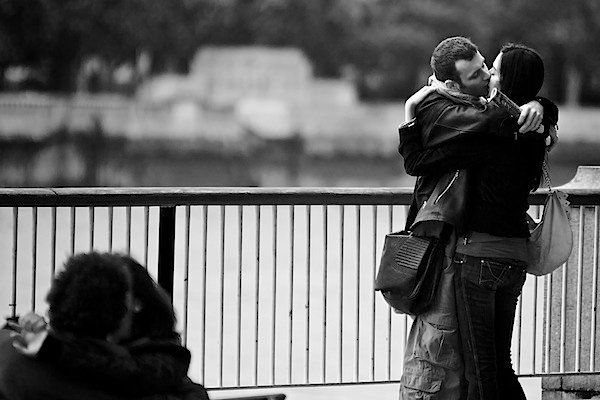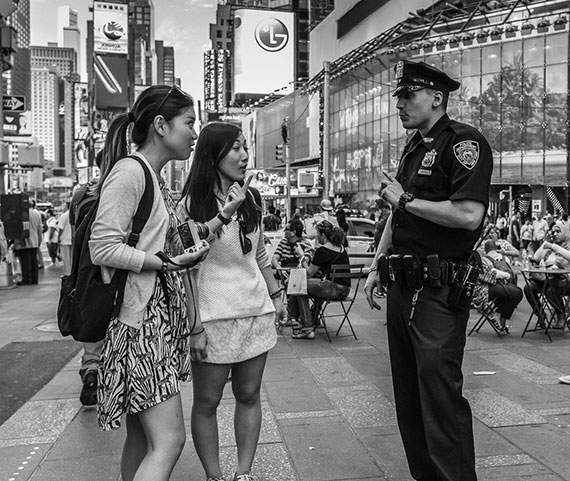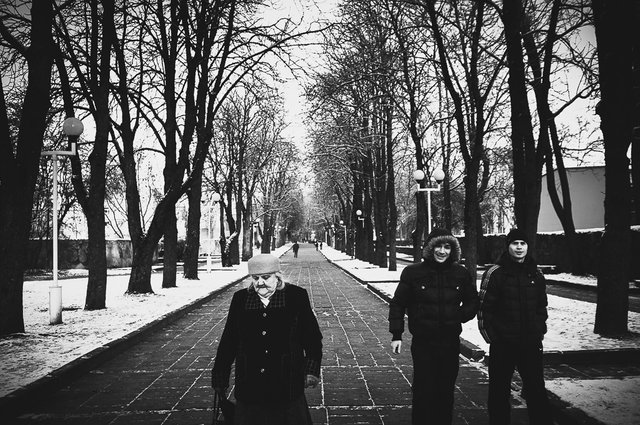
When you're beginning the test is conquering the dread of taking pictures of outsiders. Since zooming focal points are not ordinarily utilized as a part of road photography, how might you stand a couple of feet from your subject, put the camera to your eye, center, and tap the screen without getting apprehensive? A decent road picture taker isn't just dreadful in the first place (this is a decent indication of being delicate) however they likewise would prefer not to do anything which will change the how the subject is carrying on.
With training, you can defeat your hesitance to photo outsiders and additionally learn procedures which will enable you to show signs of improvement real shots. Single word of alert - it can be addictive. Sooner or later the road picture taker will pick which situate has the best view in an eatery, or which side of the road offers the best conceivable outcomes.

THE PSYCHOLOGICAL AND MORAL ISSUES
The main thing to acknowledge is that you are attacking the protection of your expected subject. You may have the best expectations on the planet, yet once you choose to point your camera at somebody without their consent, you will attack their own space. This is taking a real to life road shot. Before going into the physical systems which can make your activity simpler, it is vital to take a gander at your own particular thought processes. More often than not, you see something that you essentially need to impart to whatever remains of the world. It may be amusing, odd, puzzling, have an intriguing outline, or some other quality that you believe merits shooting. However, you are anxious about taking the photo. This is typical. When you are simply beginning, ask yourself whether you would take the photo in the event that you weren't apprehensive about your envisioned results. This may appear to be extraordinary, however imagine this is your last day on earth, and that nothing else matters except for getting this shot. Take a full breath and subsequent to taking in the different procedures recorded beneath - you ought to be prepared to get at it.

WHICH CAMERA?
A decent road camera has the accompanying qualities: a calm shade, exchangeable focal points, quick focal points (F-Stop of F2.0 or lower), no screen slack, RAW catch mode, the capacity to concentrate well in dim spots, usable high ASA, a great viewfinder and sufficiently lightweight to take with you wherever you go. I don't know about any advanced Point and Shoot camera that meets every one of these criteria. An advanced Single Lens Reflex (DSLR) will meet all or the vast majority of these properties. The Canon 40D, for instance is no heavier than a Leica M, however the quick focal points are bigger. The top of the line Point and Shoot, known as a digicam, has a portion of these highlights, however they don't have compatible focal points, and the zoom focal points are not normally speedier than F2.8 at the wide end.
The present yield of DSLRs have numerous highlights of a decent road camera.
In this way, how about we get to it. Whatever advanced camera you utilize, kill any beeping the camera makes. Likewise kill the quick playback on the LCD. Do a few tests to discover that most noteworthy ASA you can use without getting excessively advanced commotion. Once more, this is the place DSLRs are ideal. Cameras like the Canon Mark II can enable you to utilize an ASA as high as 3200 (perhaps more) without making much computerized clamor in the picture. Most simple to use computerized cameras making quiet pictures at much around 200 ASA.

Most DSLRs rely upon a tic-tac-toe grid of central focuses. Keep the inside point on, and kill the other central focuses.
For a computerized camera with a trimmed sensor, a 30mm F1.4 is a decent strolling around focal point. Sigma makes a superb one however recollect, the Sigma f1.4 30mm won't work with a full-outline sensor). In the event that you are utilizing a full-sized sensor, at that point a 35mm f1.4 focal point, in blend with a 50mm f1.4 is an astounding mix. Having a focal point that gives you a decent quality shot at F1.4 is vital. Also, in light of the fact that a focal point opens to F1.4 doesn't imply that it's great at that F-Stop, so pick this focal point painstakingly. In the Canon line, the 50mm F1.4 which is for a full sensor, and which works with an edited sensor too, is one of their best focal points and contrasted with their other F1.4 focal points is shabby.
A DSLR more often than not has a strategy for decoupling the introduction from the point of convergence. It's a smart thought. The Canon 40D and in actuality all Canon SLRs (backpedaling to the film days) have this component. You set the concentrate bolt to a catch on the back of the camera, and a half-press of the shade locks introduction. I harp on this thought on the grounds that multiple occassions you will utilize the catch on the back to pre-center your shot, and do encircling as the camera goes to your eye. The possibility that you need the camera to take it's presentation off the point of convergence doesn't bode well. As a rule, in the event that you are depending on the meter, than it's smarter to bolt center, and have the meter complete a general perusing of what's in the casing.
Regardless of whether it's a bright day, or a cloudy day - ASA 800 is a decent place to begin. You quite often need all the shade speed you can get. On the off chance that your camera creates extremely uproarious pictures at ASA 800 than it isn't the correct camera to utilize.
Never utilize a focal point top. Not whenever, for any reason. You ought to dependably have an UV channel on the focal point, which will secure the focal point and make it simple to take a speedy shot. You can simply tell a beginner on the off chance that they are utilizing a focal point top.
DRESS THE PART
You'll be taken off to a visitor spot, so dress like a traveler. I'm totally serious. In spite of the fact that you may have lived in your city for a long time, get yourself a visitor guide and dress like you have quite recently touched base from the mid-west in the midst of a furlough. I'll leave that part for you to make sense of.
Visit a swarmed vacation destination where everybody has a camera. Dress and go about as simply one more visitor. Concentrate your visitor delineate. Ogle at the point of interest like every other person. Also, watch out for intriguing subjects.
Try not to REMOVE YOUR EYE FROM THE CAMERA AFTER YOUR SHOT
Begin off like every other person. Take photos of the historic point. Keeping the camera to your eye you would now be able to look over the group for something fascinating. As you take pictures, don't expel the camera from your eye even after you have the shot you needed. Keep on moving the camera around putting on a show to take pictures. Never give away the way that you've taken somebody's photo by expelling the camera from your eye in the wake of taking the shot.
You may not discover anybody worth shooting, but rather this is a simple method to begin. It shouldn't be exceptionally unnerving, and you will locate that even while standing near your subjects you can take their photos without stirring doubt. You can utilize similar systems at road fairs, or parades. Pretty much any swarmed zone which is loaded with vacationers is a decent place to hone.
KEEP BOTH EYES OPEN, TURN OFF THE LCD
Keep your non-shooting eye open. You ought to have the capacity to take a gander at conceivable subjects even with the camera to your eye. Most DSLR cameras have a LCD screen for review pictures on the back. This ought to dependably be killed.
You simply don't need the LCD going ahead while the camera is to your eye. It's irritating and it gives away the way that you've made a go, particularly in a dim area. Likewise, if the LCD is off, and you hold the camera a bit before your face, you can see the impression of what's happening behind you.
Recognizing what is going on behind you is valuable in a road where individuals are moving around in light of the fact that you can gauge the separation the potential subject will be the point at which you pivot, and have your camera pre-centered for that shot. Obviously you'll have to check how quick they're strolling towards you, and about where you'll pivot and snap. In any case, again - as you turn keep the camera to your eye as though you are simply glancing near. You will be amazed at the fact that it is so natural to take a photo of the subjects when they are five feet or so from you without them knowing.
SHOOTING FROM THE HIP VS. HAVING THE CAMERA TO YOUR EYE
When in doubt of road photography, on the off chance that you can get the shot with the camera to your eye, you will improve shot. I realize that there is a whole school of shoot-from-the-hip photography, which you can hone also, yet you will never have the capacity to outline this kind of shot and on the off chance that you put the camera to your eye. (That is my own particular conclusion and obviously open to wrangle.) There will be times when it is just difficult to shoot with the camera to your eye, thus shooting from the hip merits learning. Be that as it may, I don't believe it's a decent method to begin.
You have to settle on choices about profundity of-field. A typical strategy for the road picture taker is depending on hyper-central separation. I don't think this is as essential with current auto-center cameras, yet the thought is that with a wide focal point, in the 30 - 35mm territory, you can set the focal point to f8, in the event that you have enough light, and set the concentration at ten feet, and realize that everything from around 6 feet to 15 feet will be in hyperfocal distance.(I'm not taking a gander at a focal point as I compose this so the correct separation and f-stop might be off, in addition to most present day self-adjust focal points do exclude a hyperfocal scale. Be that as it may, for more seasoned cameras with a hyperfocal scale on the focal point, this is an attempted and genuine method.) I simply haven't observed it to be important with current auto-center cameras.
PRE-FOCUS
For instance, with the Canon and Nikon DSLRs you can dole out concentrate bolt to a catch on the back of the camera and presentation to the shade catch. You suspect that you will shoot a specific subject, and hold the back catch down to center around them, however perhaps you aren't prepared to take their photo yet and they aren't moving much. You can keep on holding that back catch down until the point that you are prepared to take the shot, or you can turn the focal point to manual concentration while holding the conservative. At that point you can discharge the catch and realize that the concentration continues as before. Keep in mind to fail the focal point back on when you're done or all your consequent shots will be out of core interest.
Present day cameras have a network of central focuses. They are a major se
verry nice post thank you
Downvoting a post can decrease pending rewards and make it less visible. Common reasons:
Submit
World of Photography
>Visit the website<
You have earned 6.50 XP for sharing your photo!
Daily photos: 1/2
Daily comments: 0/5
Multiplier: 1.30
Block time: 2018-05-11T18:08:39
Total XP: 43.00/100.00
Total Photos: 6
Total comments: 4
Total contest wins: 0
Follow: @photocontests
Join the Discord channel: click!
Play and win SBD: @fairlotto
Daily Steem Statistics: @dailysteemreport
Learn how to program Steem-Python applications: @steempytutorials
Developed and sponsored by: @juliank
Downvoting a post can decrease pending rewards and make it less visible. Common reasons:
Submit
This post has received a 3.13 % upvote from @drotto thanks to: @maanabdullah.
Downvoting a post can decrease pending rewards and make it less visible. Common reasons:
Submit
You got a 4.02% upvote from @postpromoter courtesy of @maanabdullah!
Want to promote your posts too? Check out the Steem Bot Tracker website for more info. If you would like to support the development of @postpromoter and the bot tracker please vote for @yabapmatt for witness!
Downvoting a post can decrease pending rewards and make it less visible. Common reasons:
Submit
Howdy partner, I'm @photocurator, a curation bot; I keep an eye on the photo feeds, I vote random photos of my followers and at the end of the day I publish a post with links to the best photos. Follow @photocurator to get your photos curated in the future!
Downvoting a post can decrease pending rewards and make it less visible. Common reasons:
Submit